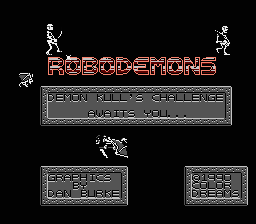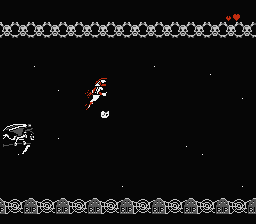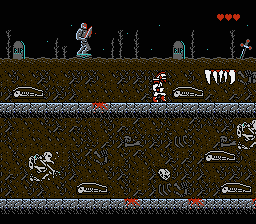Here’s another obscure NES game that hasn’t yet made the MobyGames cut. It’s an unlicensed title from Color Dreams, the company with the baby blue NES cartridges. I’m pretty sure that this will be the first time I have actually played a Color Dreams title, and don’t think I’m happy about that. Since they were unlicensed, Nintendo never mentioned word one about titles like this in Nintendo Power, my chief source for all things Nintendo when I was into the 8-bit. Due to the WWW, I have since read dozens of overwhelmingly negative reviews for unlicensed games. And so it is with much apprehension that I dutifully dive into Robodemons.

The title screen is severely lackluster but showcases what is likely to be the game’s most notable feature– scratchy digitized voices using the NES’ exceptionally limited PCM capability. When I got into the actual gameplay, I quickly hypothesized that the game probably spent most of its ROM budget on these effects.

Press the start button and jump into the story exposition. I would include a screenshot but it’s written in the same font you see in those boxes above. The only way to make it out is to get a screen capture and magnify it several times. Here is the text:
In darker times the demon Kull, king of the nether world of Hades, created a machine to transplant the souls of demons into the body of robots. With this army of robodemons Kull became the unchallenged master of the earth. One day a great warrior decided to descend the seven gates of Hades and destory [sic] Kull forever…
So I think this electronic game is trying to make the ironic case that technology is satanic. Of course, Color Dreams might be an authority regarding matters of video games and spirituality since they later re-invented themselves as Wisdom Tree, makers of religious, unlicensed titles rather than just plain old unlicensed titles.
The game starts out with some fly-through shooting action:

Our hero has a boomerang for offense. It shoots straight out in front, angles upward a bit, and then returns on a slightly higher plane. Oh, and it’s even less useful than it sounds, especially against a bunch of nimble enemies who can fire in any direction. After much trial and error with this level, I decided that pacifism is the best policy and just concentrated on avoiding threats, especially since destroying an enemy requires being lined up with it on a horizontal plane which puts the protagonist at great risk. There is also the strategy of using the boomerang’s return path to hurt enemies but that’s extremely tricky.
It’s a short flight to the skeleton demon boss who, if you still have enough health, will succumb if you just hit him head on with enough boomerangs. Then, it’s down to Hades, if I’m not mistaken. It resembles a run-of-the-mill graveyard:

So now, I have both a shoot and a jump action available to me (except that the buttons are swapped from the usual orientation provided by these games). There are skeletons, flying creatures, little rolling objects that are starkly reminiscent of Phantom of the Opera masks, and giant, disembodied fangs as seen in the preceding screenshot. When I first encountered it, I wasn’t sure if it was supposed to be jumping platform or a threat. I guessed wrong the first time. Also, the little red puddles in the ground result in your immediate death, should you step in.
I got to the boss of this level. It was a skeleton demon dog. I couldn’t beat it. I really didn’t care.
Okay, MobyGames is about to be one game closer to having a complete collection of NES titles. And I can put this unpleasantness behind me.
commodorejohn says:
Interestingly, instead of using the famously fuzzy DMC hardware for the digitzed effects as most NES games that feature speech samples do, this game does direct writes to the sound hardware – you can tell because everything pauses when a sample is played; direct-write sound is very CPU-intensive.
Multimedia Mike says:
Interesting observation. I have this sneaking feeling that this has something to do with the fact that they likely had to reverse engineer as much NES functionality as they could.